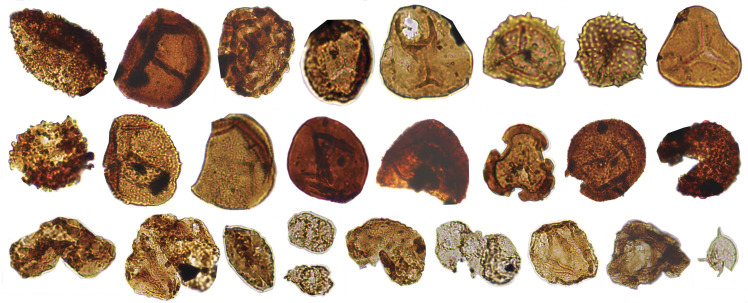EARTH, ATMOSPHERIC, AND PLANETARY SCIENCES
Rift in the Larsen C Ice Shelf on the Antarctic Peninsula on November 10, 2016. Image credit: NASA/John Sonntag.
Thinning and iceberg calving in Antarctic ice shelves
In July 2017, iceberg A68, one of the largest icebergs on record, calved off the Larsen C Ice Shelf on the coast of Antarctica, following the sudden propagation of a preexisting but dormant rift in the ice shelf. The physical properties that influence the widening of rifts in ice shelves are not well understood. Eric Larour et al. modeled the evolution of ice shelf stress balance around actively propagating rifts in response to both thinning of the ice shelf and thinning of the ice mélange—the mixture of accreted ice, blown snow, and iceberg debris that accumulates in fractures and rifts in ice shelves. The authors used measurements of shelf thickness, elevation, and surface velocity to calculate how changes in ice thickness influence rift opening rates and stability. The results suggest that thinning of the ice shelf has a healing effect on rifts. Conversely, thinning of the ice mélange increases the likelihood of rift activation and iceberg calving. Stress increases nonlinearly below a thinning threshold of 18 meters. According to the authors, the effect of ice mélange thinning has not been incorporated into existing ice shelf models and could result in ice shelf retreat decades ahead of previous estimates. — M.H.
NEUROSCIENCE
Midbrain dopaminergic neurons expressing an enhanced yellow fluorescent protein and directly projecting to the dorsal hippocampus.
Hippocampus innervation modulates formation of aversive memories
The neurotransmitter dopamine is thought to play an important role in memory and learning through its modulation of the hippocampus. However, the origin and mode of action of dopamine on hippocampus-dependent memory are unclear. Theodoros Tsetsenis et al. used viral tracing methods to identify and label a population of dopaminergic neurons near the border of the lateral ventral tegmental area and substantia nigra pars compacta of the midbrain that directly innervate the dorsal hippocampus. The authors used optogenetic manipulations to enhance dopamine release from the midbrain and found that this release facilitated aversive learning. In contrast, pharmacological inhibition of dopamine signaling in dorsal CA1 was found to reduce contextual fear conditioning acquisition. Thus, dopamine can bidirectionally regulate context-dependent associative fear learning in the hippocampus. Additionally, genetic ablation of catecholamine production exclusively in norepinephrine neurons showed that midbrain dopamine is sufficient to maintain normal contextual fear memory formation, with no locus coeruleus dopamine contribution. The findings indicate that a cluster of midbrain dopamine neurons send direct projections to the hippocampus, and midbrain dopaminergic innervation of the dorsal hippocampus helps modulate aversive memory formation, according to the authors. — S.R.
EARTH, ATMOSPHERIC, AND PLANETARY SCIENCES
Pollen, spores, and algae from the Carnian Pluvial Episode in China.
Volcanism and ecosystem changes in the Late Triassic
The Late Triassic Carnian Pluvial Episode, which occurred 234 million to 232 million years ago, was accompanied by increases in global temperature and humidity, large-scale volcanism, and the ascent of dinosaurs. Due to a lack of terrestrial data, the cause and effect relationship between these events has not been established. Jing Lu et al. analyzed sediment and fossil plant records from a lake in the Jiyuan Basin in northern China to identify volcanic activity during the Carnian Pluvial Episode. The results suggest that there were four distinct episodes of volcanism during this period, based on mercury concentration data, with the most likely source being major eruptions in the Wrangellia large igneous province in North America. The authors correlated the pulses of volcanism with significant environmental changes, including an increase in humidity and a monsoon-like climate. These changes increased runoff into the lake, deepened the lake, and decreased both oxygen levels and animal abundance. According to the authors, the relatively long interval of volcanism during the Carnian Pluvial Episode produced major terrestrial environmental changes that likely influenced the diversification of dinosaurs and the establishment of modern conifer groups. — M.H.
ECONOMIC SCIENCES
Unrepaired section of rural piped network in Kenya.
Water access rights in rural Africa
In rural Africa, around 500 million people lack access to safe drinking water, despite policy initiatives and investment to improve rural water quality and supply. Although African governments have promoted safe drinking water as a human right, maintaining waterpoints in working order amid rising maintenance costs and funding shortfalls remains a challenge. Rob Hope and Paola Ballon analyzed survey data from 1,185 households in rural, coastal Kenya to estimate water service preferences in terms of trade-offs between water quality, price, reliability, and proximity. The analysis revealed that across all categories of respondents the most efficient way to secure paying customers would be to repair waterpoint failures within 2 days, rather than the current norm of 1 month or longer. In addition, water quality and proximity ranked relatively low among the respondents’ priorities, suggesting that these attributes may be better addressed through public funding. According to the authors, matching policy goals with local preferences could help close the funding gaps that currently undermine sustainable safe drinking water access in rural Africa. — T.J.
POLITICAL SCIENCES
Trust in scientists during pandemics
The COVID-19 pandemic has strained public trust not only in governments but also in scientists, affecting attitudes toward policy enforcement and vaccination. Between March and December 2020, Yann Algan et al. conducted four waves of surveys of 54,000 individuals from 12 countries that differ in implemented nonpharmaceutical interventions (NPIs) for COVID-19. Within countries, trust in scientists was a key driver of support for and compliance with national NPIs and willingness to be vaccinated. However, in countries where governments were vocal against social distancing and related restrictions, trust in government was correlated with decreased support for and compliance with NPIs and vaccination, even when scientists recommended the opposite. Countries that experienced an overall decline in trust in scientists over the course of 2020 also experienced declining support for and compliance with NPIs. Compared with individuals who reported low trust in others, those who reported high trust in others were more willing to be vaccinated but exhibited lower support for NPIs and lower compliance with restrictions. However, the authors note, such attitudes were attributed to being more likely to trust others to respect social distancing rather than a lack of civic-mindedness. The findings suggest that sustained trust in scientists is critical for the implementation of NPIs during a pandemic, according to the authors. — M.S.
PSYCHOLOGICAL AND COGNITIVE SCIENCES
Stereotypes and social exclusion of women in STEM
Despite widespread diversity and equity initiatives, women often experience social exclusion in workplaces dominated by men. However, it is unclear why women experience exclusion and whether a lack of men-women friendships poses barriers to career advancement for women in STEM. Emily Cyr et al. surveyed 1,247 full-time STEM professionals in North America, measuring informal socializing with colleagues, implicit gender stereotyping, sense of belonging at work, and workplace engagement. Overall, women reported less social inclusion by their colleagues who are men than did men by their colleagues who are women. Both women and men more quickly associated the concept of “STEM” with “male” rather than “female,” though the observed effect of implicit gender stereotyping was stronger among men. Compared with other colleagues who are men, men who exhibited more implicit stereotyping reported socializing with fewer women colleagues, though they did not report respecting women less. Women who were socially excluded by men colleagues reported lower belonging and worse workplace outcomes compared with women who felt included. Among men, feeling socially excluded by women colleagues was weakly related to workplace outcomes and was unrelated to men’s implicit gender stereotypes. The findings suggest that men-women friendships at work may improve women’s feelings of belonging and workplace engagement, according to the authors. — M.S.
MEDICAL SCIENCES

Researchers found, for example, that people whose heart rates most closely correlated with others while listening to children’s stories were better at recalling details such as the names of characters. Image credit: Shutterstock/Alhovik.
When listeners pay close attention to stories, their heart rates synchronize
Posted on September 24, 2021
Carolyn Beans
An international team of researchers has shown that when a group of people hear the same story or watch the same video, their heart rates tend to rise and fall in synch. This correlation of heart rates, described this month in Cell Reports, could one day lead to new tools for measuring attentiveness, both in the classroom and the clinic.






